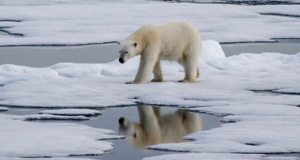From Earth Common Journal VOL. 5 NO. 1Media Initiation in Environmental Education: An Indian Model of Environmental Pedagogy
IN THIS ARTICLE
AbstractEnvironmental communication is now an emerging and a significant curriculum from schools to research centers. The effective and efficient environmental communication occurs when learners interact with their surrounding environment/ecology in which they live and reciprocate for sustainable protection and restoration of it. Developing countries in Asia and Africa are now setting up new role models and practices in curricula of environmental communication. The traditional theory based environmental communication curriculum of the last century is now actively investigated and restructured through community based learning, affirmative actions, and student centered participatory curriculum. Kerala, a southern State in India, serves as an exemplar of this new eco-venture. Through case studies like, Nalla Paadam (Good Lesson), Palathulli Project (Many a Drop Project) by the Malayalam language daily ‘Malayala Manoram', and SEED project by another Malayalam daily ‘Mathrubhumi', this paper analyses the innovative curriculum practices in the state of Kerala in India. IntroductionThe emergent trends in multi-disciplinary pedagogy opened up new vistas in teaching and learning of environmental communication through diversified and blended approaches. Environmental communication is now a significant curriculum in schools and research centers, and the possibilities of communication in relation to environmental interaction have become vital. However, the importance and impact of the environmental communication education is minimally recognized by the community. The effective and efficient environmental communication occurs when learners interact with their surrounding environment/ecology in which they live and reciprocate for the sustainable protection and restoration of it. This new approach of holistic teaching and learning through praxis now incorporates crisis/disaster management or mitigation, strategic planning, nature restoration, sustainable growth models, community centered learning, people's participation, and grassroots level self-help developments in relation with nature and humans. Developing countries of Asia and Africa are now setting new role models and practices in curricula of environmental communication. The traditional theory based environmental communication curriculum is now actively investigated and restructured through community based learning, affirmative actions, student centered participatory curriculums. Praxis of placing the primary learner (stakeholder) as the locus of curriculum implementation and evaluation is gaining prominence. Here, school students form the major target audience as environmental education should become a part of their routine in their young lives. This paper analyzes two successful case studies of such pedagogy in the southernmost state of India, Kerala. These creative and innovative curriculum practices were implemented through the collaboration of two vernacular newspapers and the State's primary school education system. The two leading news dailies in Kerala, Malayala Manorama and Mathrubhumi spearheaded these learning projects in the primary classrooms of the state schools under their supervision and guidance. These two dailies beyond their circulation and readership interest, invested their time, space, and resources among the primary school kids in popularizing the importance of environment and created awareness programs for restoration, preservation, and sustainable practices through projects like ‘Nalla Paadam' (Good Lesson), ‘Palathulli Project' (Many a Drop Project) by Malayala Manorama, ‘SEED' (Student Empowerment for Environmental Development) by Mathrubhumi. United Nations (UN), UNESCO, World Bank and many notable international agencies cited these as unique and awarded them with many acclaims and recognitions. Eco-Clubs and nature clubs with specific purpose and targets were created in each school under the leadership of these two newspapers. "Catching those Young" was the key agenda, in implementing these projects right in the primary school level of an organized learning system. These projects became highly successful in creating awareness among young children and inspired them to take their own efforts/actions for the environment, both in the school and at home. These events were blended with the school curriculum and inspired both the students and teachers to continue the initiatives outside the school also. This paper examines this innovative association between news media and the primary school education system in nurturing an eco-friendly generation. As such, this paper focuses on the collaborative models of such projects by highlighting the role played by school, media, and the significant paradigm shifts in curriculum. Environment: Global and Regional AgendaThe environment can be identified as a political body where it is spaced opposite to the development characterized as urbanization and industrialization. The frontiers of political powers took environment as a body of line to counter and support their arguments. The industrialist and capitalist also used the environment as a way of modern public relations with a brand of corporate social responsibility. When the environment became a game changer of social movements, various laws and acts were entitled to the protection of the nature. Environmental activism also came into existence which formed a parallel socio-political sphere. This sphere formed a universal profile, where the voice of nature became distinctive. The international non-profit organizations were set up as the result of universal voice of nature and its protection. The Earth System Governance Project (ESGP), Global Environment Facility (GEF), Intergovernmental Panel on Climate Change (IPCC), International Union for Conservation of Nature (IUCN), United Nations Environment Programme (UNEP), World Nature Organization (WNO) and the Centre for Science and Environment (CSE) represent examples of such bodies which collaborate with national and regional agencies for ensuring political and social rights of the environment. The idea about environment does not only frame and re-frame the dominant paradigms of nature, but also thinks about the "contemporary relations" (Milstein, 2009) of the nature. This is the space where environmental communication acquires status in primary and higher education. The students at school should be able to differentiate the dominant political ideologies connected with environmental agendas, with reality. Global agenda and conservative programs may not be applicable in specific local/regional cases. Human relations with nature should be understood in a regional way where the conservative and educational programs are conceived, taking into consideration the specific environmental attributions, climatic conditions, and social life. As far as Kerala is concerned, the major attraction of this Southern coastal State in India is its diverse ecosystems and terrains that support a vast range of flora and fauna. It is this varied demography that made Kerala one of the ‘ten paradises on earth' by National Geographic Traveler (as cited in "Tourism Beckons", 2004). The crust of this popularity lies in its eco-tourism whether it is beach surfing or mountain trekking. The result of this is the commodification of nature in the name of tourism (and conservation which in turn churn huge revenue as far as wildlife sanctuaries in Kerala is concerned which are also popular tourist destinations). Here, nature is perceived as only a medium to meet economic benefits. Although the environment has recently gained much attention from the media in Kerala through the Western Ghats Ecology Expert Panel who suggested those special zones in western ghats should be guided under greener and sustainable practices. A large part of this zone comes under Kerala territory inhabited by farmers who opposed this panel suggestions as they feared it would make their livelihood difficult. The state is known as "God's Own country" and also received international appreciation for its natural beauty (O'Dwyer, 2014). Despite these facts, Kerala also witnessed various environmental issues which even changed political equations of the state (Bijoy, 2006; Misra, 2010; Guha, 2011; Pulla, 2013; Suchitra, 2014; Vijay, 2015). Hitherto, environment movements and activism led a huge contribution in shaping up the identity and political sphere of a society. The state of Kerala with 14 revenue districts has a long history and strong background of socio-political movements that led to claim a unique place in the Indian social sphere. The real environmental issue in Kerala is even more austere. Though Kerala has 44 rivers, it is often hit by drought and lack of drinking water. It is to be noted here that Kerala is also blessed with two main rainy seasons, Southwest monsoon and Northeast monsoon, which is not sufficiently utilized. However, climate change has taken its toll on the definite seasonal pattern. This along with burgeoning demand for land (leading to deforestation and destruction of irrigation land) transferred agrarian society to a consumer State. The real effect of this environmental depletion, if not seriously considered, would be felt upon the coming generations who are already moving away from the soil to skyscrapers. Hence the main agenda of any environmental education should be to inculcate a nature-friendly living taking into consideration his/her immediate environmental surroundings. To face challenges of the future, the future leaders should be capable enough to understand those challenges and face them with the help of the knowledge acquired and skills developed from school. To break the indoor habit of classroom, education policy makers included environmental education (EE) as part of the curriculum. This will offer opportunities for rich, hands-on, real world and relevant learning across the curriculum (Archie, 2003). Also, this will ensure that they understand the proximity to nature, that they have access to views of their surroundings, and that they have daily exposure to natural settings which will increase the ability of children to focus and improve cognitive abilities (Wells, 2000). Dyment and Bell (2006) also noted the importance of natural settings for child growth, which make them physically active, more aware of good nutrition, more creative, and more civil to one another. The structures of modern schools and colleges are planned with emphasis on "green spaces." Here the scope of environmental communication (EC) is also very obvious with the role of communication in motivating and persuading students towards the environment (Tanner, 1980). The field of environmental communication as academic and research interest is emerging within the last decade in which most of the researchers laid stress on the scope, challenges and future of the field (Talay et al., 2004; Cox, 2006; Carleton-Hug & Hug, 2010; Hopkins, 2015). The role of media in communicating information about the environment is very important and vital. This role is not just the reporting of environmental issues, but providing space for educating the public and involving them in preserving it. As far as Kerala is concerned, newspapers and other media have played a pivotal role in bringing up social changes and political reforms. With over ten news channels and more than eight mainstream newspapers, media in Kerala cater to diverse audiences. It is amidst this situation that two major language dailies in Kerala, Malayala Manorama and Mathrubhumi brought forward with an innovative idea of implementing environmental communication lessons along with the regular school curriculum. The collaboration of Kerala schools and colleges with potential stakeholders like media, governmental organizations, and non-profit organizations are ideal examples of effective environmental communication in the curriculum. These creative and innovative curriculum practices were implemented through the collaboration of two vernacular newspapers and the state's school and higher education system. Education System in KeralaThe school education carries a significant role in shaping the attitude and behaviour of a child. Thus, the lessons learned and practiced in schools will have a long term effect in a person's life. Hence, the Primary education system around the world for several decades has been constantly reviewing and revamping to accommodate the changing needs and social context. The environmental awareness and concerns should cross boundaries of classroom and it should be adapted by the individual's life and become part of the future. It is based on this concept that in 1994, Kerala introduced District Primary Education Programme (DPEP), a student centred educational programme to make the primary education more effective and to provide quality education at the primary school level. The central idea of this pedagogy is ‘activity oriented classrooms' where subjects are taught based on group activities and demonstrations that could kindle their interest and make teaching and learning process more exciting and less tedious. Though the programme was initially planned for primary students, this constructive and novel pedagogy was subsequently implemented in higher classes. Rather than confining the students to the classrooms, this system tries to make students active in the teaching and learning processes by making them do group projects, seminars, social service projects, and quizzes. The teaching of lessons became more practical with students actively involved in doing minor social projects related to the topic learned in class. The evaluative process also changed drastically; not only exams, but his/her extra-curricular activities, leadership qualities, and other activities are counted while evaluating the progress of a student. As an effective educational practice, Walberg and Paik (2011) noted that external collaboration and partnership in designing curriculum and learning activities engages the student more than the usual classroom teaching approach offers. These external factors breaks the monotonous activities and engages students on a different level. Hence, the teaching process adopts community visit, educational tours, workshops, and field trips to make learning more interactive and interesting. This system holds immense possibilities for making environmental communication an essential part of the curriculum either directly or indirectly. Awareness, Knowledge, Attitude, Skills and Participation are key competencies needed for proper and successful environmental education programs (Sinha et al., 1985). Environmental Communication discusses mainly the relation between human beings and nature – and communication concerned "with the ways people communicate about the natural world because they believe that such communication had far-reaching effects at a time of largely human-caused environmental crises" (Milstein, 2009). Environmental communication can be compared with other types of communication like public relation and corporate communication in the sense that the regular contact with the environment and meaning created with the engagements of humans with nature should be clear (Rogers, 1998; Schwarze, 2006). So, this current study tries to locate how media in Kerala has actively participated in making environment a major part of the school curriculum. As part of the current study, the researchers have conducted field surveys and interviews in the districts of Kasargod, Kannur, Kozhikode, Wayanad, Malappuram, Ernakulam and Kottayam. Information was also gathered from the district and school coordinators along with the help of official websites of both newspapers for validation and clarification. Nalla Paadam, Palathulli and SEED Projects: Social Welfare Through StudentsLearning by doing, performing, exchanging and communicating are the best ways to implement the process into a student's life. Malayala Manorama through its project Nalla Paadam (Good Lesson) tries to find the inner meaning of "environment." Here "environment" extends to livelihood, settlement, economics and social concerns of the neighborhood. Palathulli Project (Many a Drop Project), another initiative by Malayala Manorama, aims to support and encourage rainwater harvesting and increase awareness about preserving water. Nalla Paadam is an overall student development program that includes environmental awareness, taking action for environment protection, finding development issues, crowd funding and crowd raising initiatives. Nalla Paadam also encourage a school citizen journalism initiative through which students are motivated to find stories from their locality that could make sense about the basic livelihood or environment. Each school will have one Nalla Paadam coordinator under whom students work. A judging team from Malayala Manorama evaluates the works of every school for a span of six months and select one school as "School of Good Lessons." The students involved in activities, engage in social and political interactions. With the support of teacher coordinator, students identify the issues concerning their locality and acts accordingly. For example, students of various districts in our study involved in activities like awareness campaign for conserving the river, helping migrant labourers by teaching them Malayalam, fund raising for helping senior homes, cleaning the backyard of the school and developing a vegetable garden, controlling road traffic in front of schools during peak hours and preparing food items for sales. The final selection procedure of Nalla Paaadam is conducted through national television where the finalists display their activities and acts to a large public what they have done in the due course. Even though the Nalla Paadam is designed to support the goal of each student and school to win the state level competition, the teachers opine that a student who is willing to participate in this endeavour is already a winner in life. The experience of social learning will be long lasting in a student's life. It transforms students' knowledge to Praxis of daily life and enables them to face the world academically, socially, and emotionally. Through Nalla Paadam, students get a chance to mingle with the society they live in. The tagline of Nalla Paadam is "Kerala created by children." SEED (Student Empowerment for Environmental Development) is a nature driven educational program started by Mathrubhumi. SEED aims at making environmental education a part of the school educational curriculum and make such activities a part of their daily life (About Seed, 2013). With the tagline, "Social Welfare through Children", SEED operates with the support of General Education Department, Government of Kerala and Federal Bank, Kerala. SEED mainly focuses on state owned schools where the syllabus and curriculum are standardized but they are also having high participation from private schools too. The project aims at paving the way for a new green culture by assembling high schools, higher secondary schools and upper primary schools in the state (About Seed, 2013). The activities and results of SEED attracted the world environmental organizations. SEED received awards from WAN IFRA Young Reader Prize, Corporate Social Crusader of the Year, AFAQS 2010, Vanamithra award and various other regional organizations.Continued on Next Page » Suggested Reading from Inquiries Journal
Inquiries Journal provides undergraduate and graduate students around the world a platform for the wide dissemination of academic work over a range of core disciplines. Representing the work of students from hundreds of institutions around the globe, Inquiries Journal's large database of academic articles is completely free. Learn more | Blog | Submit Latest in Environmental Studies |



















